I chose to visit my sit spot in the evening this time. I went in at 6:08pm on Sunday, October 13th. I chose a plant species to observe because I don’t see many organisms around in my sit spot. Also, the plant that I chose was a plant I had my eyes on since day one.
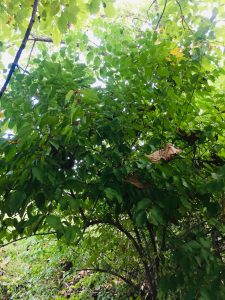
As I have mentioned in my previous blogs, the umbrella-shaped tree which looks very fascinating is the same tree that I chose to observe this time around. I did not know which plant species it belonged to and I was very curious to find that out. In my last blog, I wrote it could be a peg-wood but I later found out that it is not. It is an Amur Honeysuckle (Lonicera maackii), also known as a Bush honeysuckle or Late honeysuckle.
This large, deciduous shrub is located right beside where I sit. The reason why I picked this particular plant is that I have been witnessing it change a lot over such a short period. When I first visited my sit spot, there weren’t many leaves on it and I could clearly see all the thin and thick branches. During my second visit, I saw the growth of numerous leaves and I also saw some yellowish-green buds growing. This time around, it was all green with tiny little red berries/fruits all over. It looks really beautiful and it felt really good to see it like that. 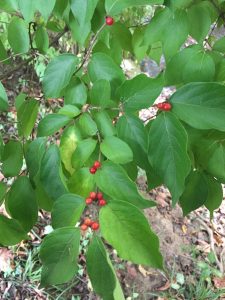
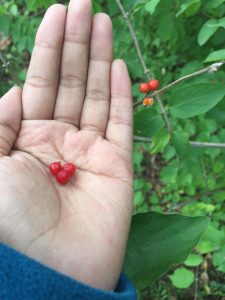 Before I figured out what it really was, I walked around it to see it more properly. To my surprise, the plant was way bigger than what it looked like from beside my sit spot. It was all expanded the branches were long stretched. I could see that all of the berries grew in clusters. What I mean to say by this is there were around 2-4 berries in one specific area and in another area there was again another cluster. This made me think about what could be the reason behind this and when I looked it up, I found that honeysuckle flowers are often produced in pairs (https://www.invasiveplantatlas.org/subject.html?sub=3040).
Before I figured out what it really was, I walked around it to see it more properly. To my surprise, the plant was way bigger than what it looked like from beside my sit spot. It was all expanded the branches were long stretched. I could see that all of the berries grew in clusters. What I mean to say by this is there were around 2-4 berries in one specific area and in another area there was again another cluster. This made me think about what could be the reason behind this and when I looked it up, I found that honeysuckle flowers are often produced in pairs (https://www.invasiveplantatlas.org/subject.html?sub=3040).
Another interesting fact I found while researching this species was that the name Amur Honeysuckle originated from the name of the river Amur where the plant was found in abundance. The river marks the border of the Russian Far East and Manchuria in China (PictureThis app). I was really excited to learn that its name was derived from a place in Asia because I am also from Asia.
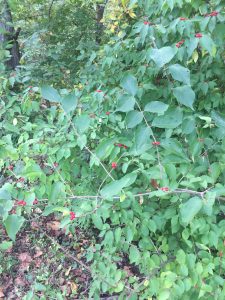
This shrub is mostly found on the edge of creeks and small streams that tend to overflow occasionally. The flowers normally appear in spring and the berries/fruits grow by late fall. The berries of this plant are mildly poisonous if eaten. (https://www.invasive.org/weedcd/pdfs/wow/amur-honeysuckle.pdf)
Since I am not good at identifying even common plants, I had to use another source to help me identify this plant. I knew I would get numerous results by looking it up on Google (a shrub with red berries/fruits). Which is why I turned to a mobile app. I used the app called “PictureThis- Plant identifier” which has a 4.7-star rating and is also trusted by biologists. I took a picture of the leaves and the berries and it immediately showed me the result saying it is an Amur honeysuckle plant. More descriptions perfectly matched the shrub that was in front of me. The picture of the leaves and branches that I found online were also very helpful and reassuring.
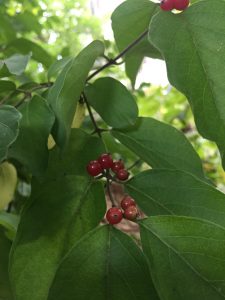
Focusing on only one particular thing was very interesting. I have never examined or observed any species for such a long time and this experience was truly great. I loved how there were so many questions popping in my head and it increased more as I got a closer look at it. And getting the answers to all those questions was also very satisfying. I love walking around in my sit spot area and I genuinely enjoyed the new experience that I had this time around.


I used a picture identifier as well! The berries are actually so adorable. Also, your description of the plant is really thorough, and it makes the reader understand fully! Cool!
This was really interesting to read! Your description was very good, and though I hadn’t encountered this plant in the same way you have in your sit spot, I felt like I was observing it right there with you after reading this blog. I’ll be interested to see how your plant changes and deals with the harsh temperature change come winter, have you been watching this plant from the beginning? Have you begun to notice and changes yet? What about to the berries, specifically? I also had never heard of the picture identifier before- that’s such a cool way to identify plants!